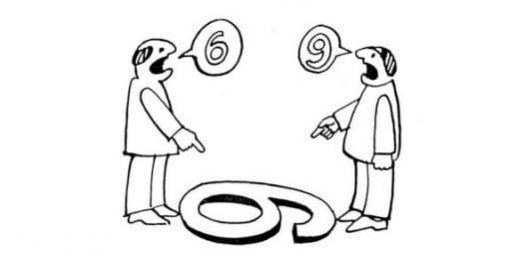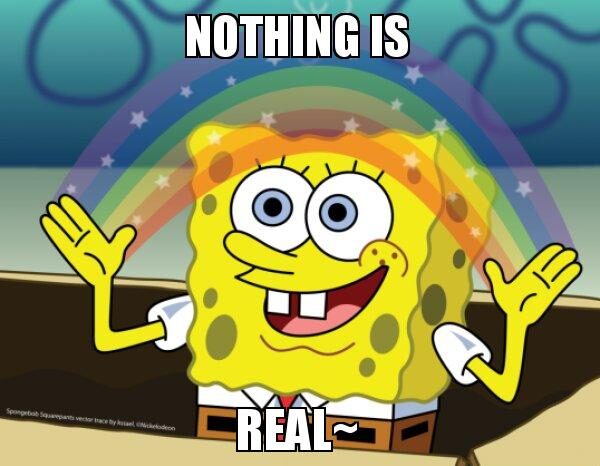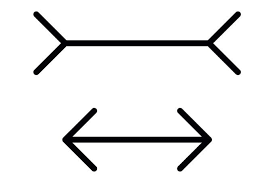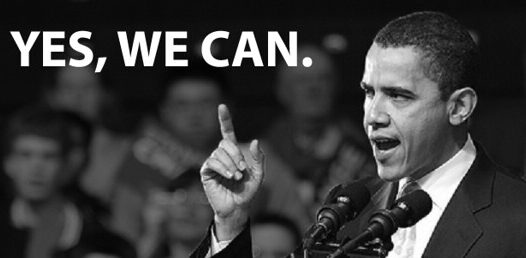
Hi All,
In this article, we are covering Perception – what it is, how we can influence it, and common misperceptions.
Side note: First, I was looking forward to getting into the topic; however, my thoughts quickly went from “Oh yes, let’s write about perception” to “Oh no, what rabbit hole am I going down here”, once I started to get into the research and all the angles from which we could be covering the content. What we perceive (i.e., the stimuli we pick up through our senses & our interpretation of this data) is ultimately what shapes our experiences and reality. Here’s a representation of how I felt after reading too much on perception:

Let’s get into it!
Perception
What is it, how can we influence it, and what are common misperceptions?
In simple terms: perception is the identification, organisation, and interpretation of sensory information, based on which we form an understanding of the world and experience life.
This can be thought of as a two-part process: (1) stimuli are picked up by our senses and travel through the nervous system to the brain, where (2) they are processed and interpreted by our (conscious and sub-conscious) mind.
What influences our perception?
Part one is relatively easy to answer: our environment. In order to sense something, we need to come in contact with it e.g., through sound, vision, touch, smell, taste.
Part two is more complex and multifaceted: it is suggested that the brain can process 11 million bits of information per second however, our conscious minds can only process up to 50 bits per second. As we covered in the publication on intuitive decision making, our subconscious holds significantly more data compared to our conscious minds (which is why intuition offers valuable guidance). But how does the brain know which information to ‘gatekeep’ and which info to let through to our conscious?
Let me introduce you to a system that sounds boring but is really cool:
The Reticular Activating System
In essence, the RAS is a bundle of neurons at our brainstem (the very back of the brain where it connects to the spinal cord), which can be thought of as a powerful filter mechanism. Unnecessary noise gets filtered out so we can process the important information. It is the reason we can be in a crowded room and focus on the conversation with the person in front of us (blending out all other voices), but snap around if we hear our name in the background.
What our brain considers important information is partly nature driven (e.g., safety-related cues), but also heavily dependent on personal worldviews, expectations, mindset, and attention.
This is the part that I referred to as the ‘rabbit hole’ earlier – perception is deeply interlinked with cognition and emotions, which are large topics in themselves. Below, a few important points:
Attention
I shared the link to the selective attention experiment at the end of last month’s publication as it is a good example of how we can influence what we see by shifting our focus. The viewer is prompted to count the number of passes while a gorilla is walking between the players. A majority of people do not see the gorilla (even though it is in their sight/visual field), simply because they directed their attention elsewhere. By consciously deciding what we want to focus on, we change what we perceive – on a playing field and in life.
Side note: Attention is a valuable limited resource. In English, we say PAYING attention (indicating inherent worth) and in German, we say ‘Aufmerksamkeit schenken’, which translates to GIFTING attention (also indicating value). With the increasing volume of information, a new attention economy has formed where attention is the main commodity.
There are various forms of attention (which we can cover in a separate publication), see one example here: research has shown that if a previously ignored stimulus has to be attended to, the brain is much slower in processing it (compared to a new stimulus) – this is called ‘negative priming’. If we have a limiting belief and don’t believe something is possible, our brain works hard to prove us right. If we then want to change this belief, it can take a while for the brain to be ‘reprogrammed’ and pick up on stimuli supporting the newly formed belief.
Mindset & Belief
You have probably heard the phrase ‘mindset is everything’ – but why is it so important? Humans are inherently prone to process information by looking for and interpreting information that is consistent with existing beliefs (confirmation bias).
If you believe you are able to develop new skills and talent through work and practice, you are likely to take action and pursue that goal. On the other hand, if you don’t believe you can shape your future, you might not even try.
“Whether you think you can, or you think you can’t – you are right.” (Henry Ford)
The same applies to how we interpret situations: For example, you went to grab lunch, walk back to the office and it starts to rain. Person A is pretty positive about life and believes to be a generally lucky person; their train of thought might be: How lucky am I to get back in time!? (Leading to a feeling of gratitude.) Person B is generally negative about life and thinks of themselves as unlucky; their train of thought might be: Of course, another day of rain in the UK! (Leading to a feeling of frustration.) One situation, two different mindsets/interpretations/lived experiences.
You can think of your mindset as a real-life V-lookup! The world is your data set and your mindset is the formula. Program wisely!
Expectations
The brain is an anticipatory machine, it is constantly trying to predict the next moment (to help us survive). Predications and expectations are driven by our beliefs.
Harvard professor Robert Rosenthal ran a study demonstrating how teacher expectations of student performance affected the actual performance of the children: Teachers were told that specific students performed highly on a test predicting future success (the test was made up and the students were picked at random). The study was run for two years and researchers found that the children who were believed to be ‘special’ did perform significantly better compared to their peers. However, that wasn’t because of an intellectual advantage, but because the interactions with the children changed “in a thousand almost invisible ways”. Teachers supported and invested in the ‘special’ children significantly more (through more specific feedback and approval, and they consistently nodded and smiled at those kids more). A classic example of a self-fulfilling prophecy – the outcome is based on action which is based on belief. (Do you believe your child to be intelligent?)
“Everything we hear is an opinion, not a fact. Everything we see is a perspective, not the truth.” (Marcus Aurelius)
Another example of how expectation influences perception: it will take you longer to recognise a person if you did not expect to see them. For example, you are on holiday and your neighbour is coincidentally in the same place. If you were in the same proximity to each other in your hometown, your brain would recognise them much faster because you have seen them there before. In scientific terms: prior experiences change the strength of connections between neurons. The strength of these connections (synapses), determines how neurons act upon one another and contains the pattern of activity that a network of interconnected neurons can generate.
Misperceptions: mind the mind-errors
Illusions:
Illusions are misinterpretations of stimuli that lead to an incorrect perception. You might be familiar with the ones below where we misjudge depth, colour, length.



If we misinterpret the colour of a circle, for example, the consequences are relatively minor. But what if we misinterpret information with much greater significance? Bringing us to the next point…
Biases:
We are all impacted to some extent. As we know, attention is a limited resource and our brains cannot evaluate every situation from scratch, which is why we rely on mental shortcuts. The list of cognitive biases is long (we can cover them in a separate publication), but for now: we should all reflect our thinking as much as possible to ensure we can judge situations as fairly as possible.
Social media:
We know that most photos are edited, right? But do we? This is going back to part one: environment. For example, a young woman consumes thousands of ‘perfect’ images. Her subconscious will soon perceive the presented beauty standard as the norm, despite knowing consciously that these pictures are edited. If the reflection in the mirror deviates from the perceived ‘perfect’, dissatisfaction increases drastically. Overall, it is easier to consciously decide what to consume, than to try and consciously control perception!
Artificial intelligence:
One, we have access to more information than ever before, and two, we increasingly draw information from online sources. What if we cannot control anymore what is real and what isn’t? Information translates into beliefs, which translates into behaviour and real-life consequences. One example: deep fakes have become so advanced that it is near to impossible to tell which images/videos are real and which aren’t. Technology is progressing significantly faster than legislation and currently deep fakes are distributed on the internet causing real-life people real-life harm. (To add: We discussed AI in university a lot, mainly in relation to the topic of consciousness, but also because the development of AI is drawing on neuroscientific knowledge – if the goal is to create a human-like machine, we need to understand first how humans function. How do babies learn? What are fundamental developmental steps? For everyone interested in AI and potential dangers, I found the Diary of a CEO podcast episode with Mo Gawdat (former Google X CBO) interesting!)
Before we wrap up: If you enjoy Neuroscience Musings and would like to support my work, here’s a way: Ko-fi.com/neurosciencemusings – If you decide to do so: THANK YOU!
Closing words
Unless we invest the time and energy to reflect on our belief systems & thinking patterns, we run on autopilot (i.e., outlive the worldview that we adopted as a result of our environment).
You might have heard people say ‘You can re-program your brain’ (mainly referring to neuroplasticity), and the first step in that is to consciously decide what you do and do not want to experience in your life.
Can we control everything that the Reticular Activating System filters? – No. But can we steer the ship in the right direction? – Absolutely, yes!

“Perception is a mirror not a fact. And what I look on is my state of mind, reflected outward.” (Ralph Waldo Emerson)
I’d love to hear your opinion on this topic! Reach me on instagram @neuroscience.musings.
Have a great day!!
Best regards,
Sarah
References:
- Marshel, J. H., Kim, Y. S., Machado, T. A., Quirin, S., Benson, B., Kadmon, J., … & Deisseroth, K. (2019). Cortical layer–specific critical dynamics triggering perception. Science, 365(6453), eaaw5202.
- Landwehr K. The Prospects of Utilizing Geometrical Visual Illusions as Tools for Neuroscience. Symmetry. 2022; 14(8):1687. https://doi.org/10.3390/sym14081687
- (My uni lecture notes)
- https://neuroscience.stanford.edu/news/why-mindset-matters
- https://www.britannica.com/science/confirmation-bias
- https://davidamerland.com/seo-blog/1405-how-your-expectations-affect-your-perception.html#:~:text=Predictions%20are%20based%20on%20beliefs,expect%20it%20to%20be%20there.&gsc.tab=0


